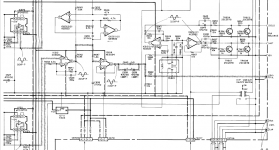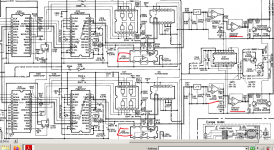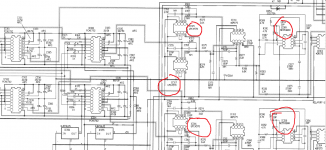IIRC Doug Self here on diyaudio said to use 4.7 pF and to have no problems (no oscillations)he NE5534A is only internally compensated for gain ≥3; unity gain applications require a compensation cap of 22pF,
I was going to mention the BGW amps, had 106db signal to noise, .1% distortion, sound great considering what they are, and the lack of any real bias.
As I remember reading, the op amp swaps (lm49720,NE5532,ad827, etc.)in those circuits were not very well received, despite how they might perform in other typical applications.
As I remember reading, the op amp swaps (lm49720,NE5532,ad827, etc.)in those circuits were not very well received, despite how they might perform in other typical applications.
I was going to mention the BGW amps, had 106db signal to noise, .1% distortion, sound great considering what they are, and the lack of any real bias.
As I remember reading, the op amp swaps (lm49720,NE5532,ad827, etc.)in those circuits were not very well received, despite how they might perform in other typical applications.
In todays also many producers using for final mastering Ampex ATR-102
or AMPEX ATR-102 Software plug in. The eart of Ampex ATR-102 was LM318
If the LM318 is a poor sounding OP amp, nobody will use AMPEX ATR-102 more than 40 years later.
In PA application with LM318, BGW 100 - 750 series was one of the best sounding PA amplifier in club installation
NO DOUBT that the ATR-102 was/is the king of analog tape recorders; but you must realize that many of those ATRs have been modified--those machines were so excellent in many other aspects (no pinch roller, complete supply and take up tension sensing, servo-controlled motors; all resulting the best tape handling of any machine). That doesn't mean that they cannot benefit from a better, lower distortion op amp replacement.In todays also many producers using for final mastering Ampex ATR-102 or AMPEX ATR-102 Software plug in. The eart of Ampex ATR-102 was LM318. If the LM318 is a poor sounding OP amp, nobody will use AMPEX ATR-102 more than 40 years later.
NO DOUBT that the ATR-102 was/is the king of analog tape recorders; but you must realize that many of those ATRs have been modified--those machines were so excellent in many other aspects (no pinch roller, complete supply and take up tension sensing, servo-controlled motors; all resulting the best tape handling of any machine). That doesn't mean that they cannot benefit from a better, lower distortion op amp replacement.
For benefit, NE5534A ?
is this real audible replacement and is ist worth ?
I see also many professional products using NJM4580
The NE5534A seems to be an excellent choice. The NJM4580 is a decent op amp; I just don't like NJR's sneaky way of presenting their specs. The 4580 has a rather pedestrian slew rate of 5nV/µSec (NE5534A=13); voltage noise of ~3.5nV√Hz (same as 5534); unspecified current noise; THD of ~-94 db @ 1 volt (~same). They are cheap, though!! 71¢ each.
As far as audibility goes, I don't know---I've never (as yet) compared them side-by-side. I've always viewed the 5534 as the gold standard of audio opamps. There are certainly ones that MEASURE better (such as the LM4562), but I think that difference is maybe inaudible. The LM318, however, appears to be in a class below the 5534--although much faster, it is also much noisier, and evidently has much more distortion. I suspect those differences ARE audible.
As far as audibility goes, I don't know---I've never (as yet) compared them side-by-side. I've always viewed the 5534 as the gold standard of audio opamps. There are certainly ones that MEASURE better (such as the LM4562), but I think that difference is maybe inaudible. The LM318, however, appears to be in a class below the 5534--although much faster, it is also much noisier, and evidently has much more distortion. I suspect those differences ARE audible.
Last edited:
I've updated the noise tool Opamp Noise Visualizer
There indeed were errors which are now resolved - my thanks for pointing them out.
🙂
There indeed were errors which are now resolved - my thanks for pointing them out.
🙂
Yay! 😀
And some people don't like negative feedback. Seems to work splendidly.
Note: Vn for default LM4562 and NE5534A entries is still incorrect (worst-case 4.7 and 4.5 instead of typical 2.7 and 3.5).
As an aside, I happened to notice that OPA1622 current noise spec seems inconsistent with its typical input bias current spec - they claim 0.8 pA/√(Hz), yet at 1.2 µA of Ib, current shot noise would yield almost 0.9 pA/√(Hz) all by itself.
And some people don't like negative feedback. Seems to work splendidly.
Note: Vn for default LM4562 and NE5534A entries is still incorrect (worst-case 4.7 and 4.5 instead of typical 2.7 and 3.5).
As an aside, I happened to notice that OPA1622 current noise spec seems inconsistent with its typical input bias current spec - they claim 0.8 pA/√(Hz), yet at 1.2 µA of Ib, current shot noise would yield almost 0.9 pA/√(Hz) all by itself.
Noise models aren't perfect representations of reality. Shot noise formula assumes charges pass a barrier independently, whereas electric fields can coordinate their passage to be more uniform. For instance metal film resistors don't normally display measurable shot noise.
Also there's a bit of slack in the two "typical" values for Ib and In, as they will be rounded up or down and perhaps measured in somewhat different setups and different sample sets?
Also there's a bit of slack in the two "typical" values for Ib and In, as they will be rounded up or down and perhaps measured in somewhat different setups and different sample sets?
I would think that if the Signetics NE5532 sounded better in that application (BGW)that it would have been used instead of the lowly lm318, since they were available at the time those were being made.
Something to ponder anyways.
Something to ponder anyways.
Firstly, I was speaking of the NE5534A, which is both quieter and faster than the NE5532. Secondly, the NE553x parts came out in September of 1977; this was well after the development of the Ampex ATR-102 (~1975)---I don't know about the BGW's history. I'm STILL betting that the NE5534A sounds better than an LM318.I would think that if the Signetics NE5532 sounded better in that application (BGW)that it would have been used instead of the lowly lm318, since they were available at the time those were being made.
Something to ponder anyways.
Yay! 😀
And some people don't like negative feedback. Seems to work splendidly.
Note: Vn for default LM4562 and NE5534A entries is still incorrect (worst-case 4.7 and 4.5 instead of typical 2.7 and 3.5).
As an aside, I happened to notice that OPA1622 current noise spec seems inconsistent with its typical input bias current spec - they claim 0.8 pA/√(Hz), yet at 1.2 µA of Ib, current shot noise would yield almost 0.9 pA/√(Hz) all by itself.
You can download the tool and enter any data or opamps. Those are just screen shots.
I usually use worst case 1 kHz data - but the tool will let you enter what you like.
🙂
I wouldn't bet all my money on ne5532 .Denon didn't either in some of their best models of the time...and i'm not even talking about full Japanese products of the 90's...2000, where you can't even find anything else,but Mitsubishi and JRC op-amps inside...So all of these players's greatness passed through a UPC4570 first....I would think that if the Signetics NE5532 sounded better in that application (BGW)that it would have been used instead of the lowly lm318, since they were available at the time those were being made.
Something to ponder anyways.
Attachments
Yes, it's mo' bettah now!! The only thing I see, however, is that you didn't allow for difference in source IMPEDANCE(used to calculate current noise) and source RESISTANCE(which should be used to calculate the Johnson noise). This would allow for sources that aren't totally resistive--for instance, my Shure V-15 Type III cartridge is 500 mH inductance and 1.35 K Ω resistance. That adds to a source impedance of 3.42K for current noise, but you must use 1.35K Ω in calculating the Johnson noise.I've updated the noise tool.There indeed were errors which are now resolved - my thanks for pointing them out.
I just looked at the uPC4570 - not a bad dual bipolar opamp given it’s vintage. 7V/us SR, typical noise voltage density of 4.5nV/rt HZ and 0.65pV/rt Hz noise current density.
Yes, it's mo' bettah now!! The only thing I see, however, is that you didn't allow for difference in source IMPEDANCE(used to calculate current noise) and source RESISTANCE(which should be used to calculate the Johnson noise). This would allow for sources that aren't totally resistive--for instance, my Shure V-15 Type III cartridge is 500 mH inductance and 1.35 K Ω resistance. That adds to a source impedance of 3.42K for current noise, but you must use 1.35K Ω in calculating the Johnson noise.
I am working on a took for phono noise calculation. Because of the reactive nature of the source (as you mention) and the RIAA equalization, you have to split the audio range up into bands, calculate the total input noise per band, apply the associated EQ and then RMS sum all the resultant noise.
What comes out is that the cartridge really dominates the noise and even with a noiseless EQ amp, you’re still not much better than 74 or 75 dB S/N with a typical MM cart - say 1k resistance and 800 mH.
The only place where you can really make a difference is with one of those high output MC carts where the R and L are both low - the Hana ML is an example, but there are others.
Stuart Yanniger who used to be active here has a very nice spread sheet On his site that allows you to input you cart details and from that it will tell you the absolute best S/N you can expect with a noiseless EQ amp. The reality is quite disappointing!
Here is the link to his spread sheet:-
SYclotron Audio | RIAA Noise Calculator
Last edited:
Kendall says in one of its article that it is a mistake to believe that all the specs of an op-amp hold together ...I just looked at the uPC4570 - not a bad dual bipolar opamp given it’s vintage. 7V/us SR, typical noise voltage density of 4.5nV/rt HZ and 0.65pV/rt Hz noise current density.
I think he says that because the specifications are quoted at certain operating conditions eg +-15V, 2 k load at 25C.
The actual measurement parameters are then taken at specific points eg noise usually 1 kHz and 100 Hz, input bias, offset all at similar points. You don’t ever see specs that cover every operating point. Too expensive to do and especially so if you’re having to qual a part for say Auto or industrial.
The actual measurement parameters are then taken at specific points eg noise usually 1 kHz and 100 Hz, input bias, offset all at similar points. You don’t ever see specs that cover every operating point. Too expensive to do and especially so if you’re having to qual a part for say Auto or industrial.
He's a bit more subtle than that 🙂I think he says that because the specifications are quoted at certain operating conditions eg +-15V, 2 k load at 25C.
.
Planet Analog - Use it or Slew it -
see discussion here:
https://www.diyaudio.com/forums/ana...oundcraft-1600-mod-results-6.html#post6071113
Quote @sgrossklass " You can't compare BJT and FET input slew rates directly. Generally speaking, BJT slew rate is more "valuable" by as much as a factor of 2 or so. This is due to the differences in differential amplifier characteristics. When plotting output slew rate over input voltage differential, undegenerated BJTs will reach maximum at maybe 60 mV, while FETs show a much more gradual increase and may need a volt or so."
As internally LM318, ne5532/34 and TDA1034 are virtually identical , uncompensated vs compensated slew rates talks show that the japanese op-amps like M5220, upc4570, njm2043, njm2068 have basically the same performance when used in high gain circuits as i/v converters with apparently a little bit better noise performance in their SD versions and the fact that most manufacturers preferred the japanese op-amps over ne5534 in their lowest noise, high gain applications like tape heads preamps or I/V converters after DAC while they used njm2114 , ne5532/34 in unity gain, low output impedance applications like post dac image filters and unity gain impedance adapters , all these together look like the same discussion as in "Use it or Slew it!"article!
Last edited:
- Home
- Amplifiers
- Solid State
- LM318 distortion


